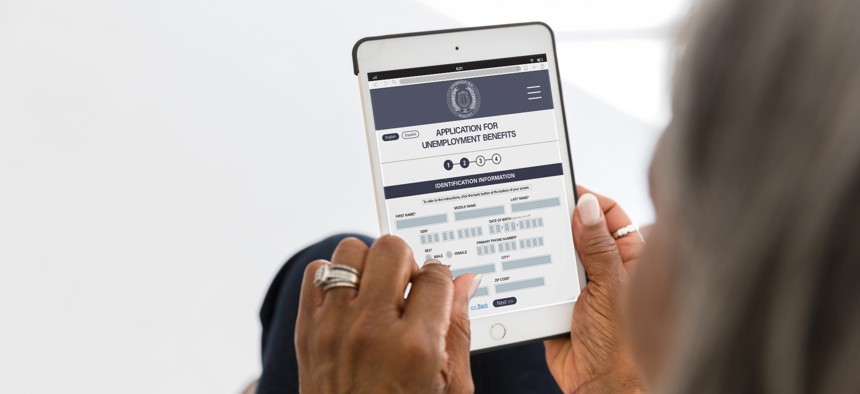No easy fix for ID verification for government benefits

SDI Productions/Getty Images
While states are looking for turnkey solutions to qualify applicants for government programs, many individuals without the right credentials can fall between the cracks.
The federal government and the states are coping with striking a balance between battling fraud in unemployment insurance claims and making sure qualified applicants can access benefits to which they are entitled. Some experts warn that anti-fraud measures can curtail access to benefits among those who legitimately need them.
Identity verification is a new area for unemployment programs, said Michele Evermore, deputy director for policy in the Department of Labor's Office of Unemployment Insurance during a conference on identity technology on Monday. It wasn't something done before the pandemic for normal unemployment insurance, she said.
Normally, after someone files for unemployment insurance, the workforce agency would check with their employer that they lost their job for the reasons they said that they did, said Evermore at the virtual event, which was sponsored by the Better Identity Coalition, the FIDO Alliance and the ID Theft Resource Center (ITRC).
Since the onset of the pandemic, issues with fraudulent claims have risen as states implemented new UI programs as a result of COVID relief legislation passed in Congress. States grappling with antique systems have looked for commercial solutions to guard the front door of benefits systems from identity thieves and fraudulent claimants.
At least 27 state unemployment programs now are working with ID.me, a commercial identity verification provider, according to Blake Hall, the company's founder and CEO.
Hall touted his company's ability to help states wade through claims that have been tied up as being potentially fraudulent, citing Florida as a specific example of where ID.me was able to verify the identities of many legitimate claimants who had been flagged for potential fraud issues.
But others said that equity issues remain for those who are unable to access benefits without passing through ID verification first, whether it be through ID.me or other services.
Identity proofing solutions likely work for about 80% of people, estimated Linda Miller, principal at Grant Thornton's advisory services and former deputy executive director of the Pandemic Response Accountability Committee (PRAC). But others run into issues with technology and documentation.
"There's a variety of things that will dissuade and or create barriers for people to use an identity proofing solution, and so while I think it's incredibly beneficial and has reduced fraud a lot, we have a long way to go as an anti-fraud community when it deals with government beneficiaries to come up with a solution that's going to address the fact that many government beneficiaries are vulnerable people and this solution isn't a solution for vulnerable people," said Miller.
"You have to be pretty sophisticated even to use something like Login.gov and always have access, remember your passwords, remember what email address you used when you first set up your account, things like that," echoed Susan Gibson, inspector general at the National Reconnaissance Office and chair of the PRAC's working group on ID fraud reduction and redress.
She said that her working group is looking more at how in-person authentication can be provided both for getting the benefit initially and for proving you are who you say you are if your identity's been stolen.
Hall also emphasized that he agreed that in-person options need to be in place for people to verify their identities to get government benefits.
There are also issues with whether someone has the documentation being asked for, said Julia Simon-Mishel, supervisor at Philadelphia Legal Assistance's unemployment unit.
The "core issue," she said, "is that a lot of individuals in our country just don't have documentation that establishes their identity."
Even if they do, experts said that problems remain in terms of people having a way to authenticate their identity if it has been stolen.
"People didn't even have a way to report, let alone a way to say, hey this is the real me. Can you authenticate that it's me and give me the stuff I'm entitled to? So that's the other thing that we're really starting to focus on now," said Gibson. "Really, the government needs to be a big part of that solution because they're a big part of the problem."
Simon-Mishel said that one thing she's run into as well is problems linking commercial ID verification systems with state agencies.
"What we've done is we've created kind of a brand new eligibility requirement that didn't exist in the unemployment system before, which is that in order to be eligible for benefits you have to prove you are you, but there is very little due process that goes along with that element and very little communication to claimants," Simon-Mishel said.
The Labor Department historically hasn't been involved in the tech side of unemployment programs, but is also currently working on solutions, said Evermore. A pilot meant to help states integrate ID verification into their systems is underway in Arkansas and New Jersey.
In the meantime, the issue impacts those who legitimately need benefits, said Gibson.
"There's very little being done for victims of identity fraud, for the people who go to apply for their unemployment insurance and find out somebody's got it ahead of them," said Gibson. "It takes them weeks or months to even get a call back when they report, and this is somebody who needs their unemployment insurance. By the time they get helped, are they also homeless? Are their children hungry?"






